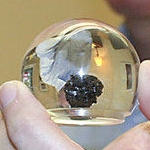 |
| Joseph Gutheinz, a retired NASA investigator and self-appointed moon rock hunter, stands before the lunar samples vault at Space Center Houston. (James Nielsen, Houston Chronicle / February 8, 2012) |
 |
| Tranquillitatis mare basalt sample entrusted to North Carolina and found in NC Dept. of Commerce desk drawer four decades later [Charlotte Observer]. |
Los Angeles Times
Alaska's moon rocks disappeared on Sept. 6, 1973.
A fire set by an arsonist had torn through the state transportation museum in Anchorage, where the four rocks had been on display.
The fragments, each smaller than a pea, were among 48 pounds of lunar material retrieved four years earlier by astronauts aboard Apollo 11. President Nixon gave samples to each state to celebrate man's first walk on the moon.
The Alaska museum curator's stepson, 17-year-old Arthur Coleman Anderson, sneaked inside the disaster scene to poke through the debris. He came across a Lucite ball mounted on a walnut plaque featuring the state flag. Inside the ball were four rocks.
Anderson figured the plaque, once cleaned up and polished, would make a neat souvenir. And so, as clean-up crews set about their work, he walked away with a national treasure.
It would be nearly 37 years before he attracted the attention of the moon rock hunter.
 |
| State of Ohio's four 'pea-sized' Apollo 11 samples display; gift from President Nixon similar Alaska's, eventually lost for 37 years. |
"I hate incompetence," Joseph Gutheinz said. He was in his Houston-area law office, seated at a desk adorned with a silver-and-black globe labeled "moon rock hunter."
It irks Gutheinz, an Army veteran, retired NASA investigator and the son of Camp Pendleton Marines, that authorities have allowed hundreds of lunar rocks to disappear or fall into the hands of businessmen, dictators and thieves.
It is illegal for individuals, even astronauts, to own moon rocks. The U.S. distributed samples to states and nations as signs of goodwill — symbols of extraordinary human achievement intended to be displayed — and many of them are unaccounted-for.
Hundreds of rocks that NASA loaned to researchers have also been lost or stolen over the years, the space agency's inspector-general reported in December.
"To me, NASA's missions to the moon have been a tribute to the best of mankind, and NASA's handling of the moon rocks recovered by our astronauts has been lacking," Gutheinz said.
Read the full Los Angeles Times feature story HERE.

No comments:
Post a Comment